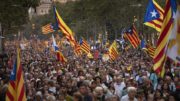Riots and grief in Catalonia
The massive and increasingly violent demonstrations — or insurrection — in Spain’s second city, Barcelona, fabled for its architecture and culture and what Catalans call seny (“good sense”), with echoing mayhem in Girona and Lleida and blockages of highways connecting those cities with the outside world have nearly monopolized the news in Spain. It seems odd that they have been given such scant attention in The New York Times or the Washington Post (on the days of greatest violence, I found nary a mention on their front web pages), but then there are lots of other disasters occurring right now: Syria, Quito, Santiago de Chile, Hong Kong, Culiacán, just to mention a few of the most violent. But in Spain, it’s almost all the news we see; on the national TV station, even when reporting on some other issue, the screen shows an inset of the latest activity in Barcelona, such as police charges, the burning of garbage containers, fires set to automobiles, heavy and sometimes lethal objects hurled at police, etc.
And we ask, Why is this occurring? Why is always two questions: To what end, and from what cause.
To what end: If you are even aware of these demonstrations, you have seen huge crowds marching to key points of the city (around police and government offices, especially) with banners and shouts of their demands. Mainly, the release of what independentistas in Catalonia describe as “political prisoners,” the secessionist leaders recently sentenced to long prison terms, in one case, Oriol Junqueras, 13 years. They were in fact condemned for inciting violence and/or misappropriating public funds, not for their advocacy of independence (which is legal), so whether their offenses should be called “political” is at least debatable. And by Spanish law (or the law of almost any democratic society), a sentence by the high court can be reversed only by appeal to a higher court (in this case, the defendants will have to take it to the European tribunal), not by a dictum by the executive. How they got into that situation, the series of blunders and deceptions by politicians on both sides of the independence issue, is a lamentable story, but the Spanish judges seem to me to have done the best possible to give them a fair trial.
But though the trial verdict was the latest trigger, that’s not what’s driving the great mass of the thousands of Catalans to protest. Many, maybe most, of them believe (or say they believe) that Catalonia has been mistreated by the rest of Spain and should and can become an independent republic. Their leaders, the ones who instigated the secessionist movement, know that both these arguments are ridiculous, especially the second one. Catalonia could not possibly become independent, first, because most of its people don’t want to (and such a rupture would require huge support which the independentistas have never been able to rally), second, because it doesn’t have the institutional infrastructure nor the resources to create it, and third, because the resulting small republic (7.6 million people) would suddenly be outside the European Union and have to negotiate commercial and other accords as a “third country.” Also, Catalonia’s trade, the source of its wealth, is overwhelmingly with the other Spanish regions. So why even pretend?
On the cause: I’ve written about this before in more detail (The Pain in Spain) so here I’ll just sum up my argument. A very large portion of the Catalan population (nearly half, according to polls) has been deliberately misled to satisfy the interests of at least two very different political factions: the corrupt leaders of the conservative party that was long in power in the region, and who saw the movement as a way to forestall investigations into their long criminal history, and the nominally leftist, socialist leaders who wanted to free the region from the austerity policies of the central government of Spain, which at the time all this started was run by the very conservative and very clumsy so-called “Popular Party.”
The people who are causing the destruction are something else. The police calculate there are about 500 ringleaders, coordinating and directing the attacks, and many of them are not even from Catalonia. They are “anti-system,” taking advantage of a big popular movement to try to destroy public order. The police also calculate that the active burners, missile-hurlers, pavement destroyers, and incendiaries are about 2,000 young people, mostly very young. Among them surely are many who are just seeking excitement and approval from their peer group.
So far, the constitutional order has held, though the police are exhausted and (I believe, though I haven’t yet seen figures) have suffered more injuries than the demonstrators.
